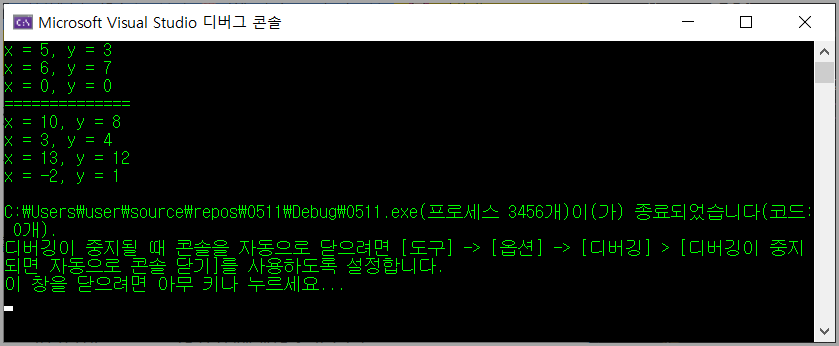프렌드함수
: 클래스의 멤버 함수가 아닌 외부함수
: 전역 함수
: friend 키워드로 클래스 내에 선언된 함수
: 클래스의 멤버로 선언하기에는 무리가 있는, 클래스의 모든 멤버를 자유롭게 접근할 수 있는
일부 외부 함수를 작성 할 때 필요하다.
클래스의 모든 멤버를 접근할 수 있는 권한이 부여된다.
프렌드 함수가 되는 세가지
: 전역함수 - 클래스 외부에 선언된 전역 함수
: 다른 클래스의 멤버 함수 - 다른 클래스의 특정 멤버함수
: 다른 클래스 전체 - 클래스의 모든 멤버 함수
1. 외부함수 equals() 를 Rect 클래스의 프렌드로 선언하는 것
class Rect{
friend bool equals(Rect r, Rect s);
}
#include <iostream>
using namespace std;
class Rect;
bool equals(Rect r, Rect s);
class Rect {
int width, height;
public:
Rect(int width, int height) {
this->width = width;
this->height = height;
}
friend bool equals(Rect r, Rect s);
};
bool equals(Rect r, Rect s) {
if (r.width == s.width && r.height == s.height) return true;
else return false;
}
int main() {
Rect a(3, 4), b(4, 5);
if (equals(a, b)) cout << "equal" << endl;
else cout << "not equal" << endl;
}

2. RectManager 클래스의 equals 멤버 함수를 Rect 클래스의 프렌드로 선언하는 것
class Rect{
friend bool RectManager::equals(Rect r, Rect s);
}
#include <iostream>
using namespace std;
class Rect;
class RectManager {
public:
bool equals(Rect r, Rect s);
};
class Rect {
int width, height;
public:
Rect(int width, int height) {
this->width = width;
this->height = height;
}
friend bool RectManager::equals(Rect r, Rect s);
};
bool RectManager::equals(Rect r, Rect s) {
if (r.width == s.width && r.height == s.height) return true;
else return false;
}
int main() {
Rect a(3, 4), b(4, 5);
RectManager man;
if (man.equals(a, b)) cout << "equal" << endl;
else cout << "not equal" << endl;
}

3. RectManager 클래스 전체를 Rect 클래스의 프렌드로 선언하는 것
class Rect{
friend RectManager;
}
#include <iostream>
using namespace std;
class Rect;
class RectManager {
public:
bool equals(Rect r, Rect s);
void copy(Rect& destm ,Rect& src);
};
class Rect {
int width, height;
public:
Rect(int width, int height) {
this->width = width;
this->height = height;
}
friend RectManager;
};
bool RectManager::equals(Rect r, Rect s) {
if (r.width == s.width && r.height == s.height) return true;
else return false;
}
void RectManager::copy(Rect& dest, Rect& src) {
dest.width = src.width; dest.height = src.height;
}
int main() {
Rect a(3, 4), b(4, 5);
RectManager man;
man.copy(b, a);
if (man.equals(a, b)) cout << "equal" << endl;
else cout << "not equal" << endl;
}

연산자 중복
연산자를 재정의 해 사용할 수 있는 것이다.
: c++ 에 본래 있는 연산자만 중복 가능하다.
: 피 연산자 타입이 다른 새로운 연산 정의
: 연산자는 함수형태로 구현한다. -> 연산자 함수
: 반드시 클래스와 관계를 가진다.
: 피연산자의 개수를 바꿀 수 없다
: 연산의 우선 순위 변경은 안된다.
: 모든 연산자가 중복가능하지 않다.
: 예를 들어, . 이나 :: , ?: (3항 연산자) 등이 중복 불가능하다.
연산자 함수 구현방법 2가지
연산자 함수는
1. 클래스의 멤버함수로 구현
2. 외부함수로 구현하고 클래스에 프렌드 함수로 선언
하는 두가지의 방법으로 구현 가능하다.
함수의 형식은 아래와 같다.
리턴타입 operator연산자(매개변수리스트);
연산자 중복 예제 1
#include <iostream>
using namespace std;
class Test {
int x=0, y=0;
public:
Test(){ }
Test(int x, int y) {
this->x = x;
this->y = y;
}
~Test(){}
void show() {
cout << "x = " << x << ", y = " << y << endl;
}
//Test operator+(int k) {
// x += k;
// y += k;
//}
//Test operator-(int k) {
// x -= k;
// y -= k;
//}
Test operator+(int k) {
x = this->x + k;
y = this->y + k;
return *this;
}
Test operator-(int k) {
x = this->x - k;
y = this->y - k;
return *this;
}
Test operator+(Test op) {
Test tmp;
tmp.x = this->x+op.x;
tmp.y = this->y+op.y;
return tmp;
}
Test operator-(Test op) {
Test tmp;
tmp.x = this->x - op.x;
tmp.y = this->y - op.y;
return tmp;
}
};
int main() {
Test a(5, 3), b(6, 7),c(5,3), t,s;
a.show();
b.show();
t.show();
cout << "==============" << endl;
a.operator+(5);
a.show(); // x = 10, y = 8
b.operator-(3);
b.show(); // x = 3, y = 4
t = a.operator+(b); // a.operator+(b)
t.show();
s = b - c;
s.show();
}

연산자 중복 예제2
class Color {
int r=0, g=0, b=0;
public:
Color(){}
Color(int r, int g, int b) {
this->r = r;
this->g = g;
this->b = b;
}
Color operator+(Color a) {
Color tmp;
tmp.r = this->r + a.r;
tmp.g = this->g + a.g;
tmp.b = this->b + a.b;
return tmp;
}
bool operator==(Color a) {
if (this->r == a.r && this->g == a.g && this->b == a.b) {
return true;
}
return false;
}
friend Color operator+(int n, Color a);
void show() {
cout << this->r << " " << this->g << " " << this->b << endl;
}
};
Color operator+(int n, Color a) {
a.r += n;
a.g += n;
a.b += n;
return a;
}
int main() {
Color red(255, 0, 0), blue(0, 0, 255),green(0,250,10),c;
c = red + blue;
Color fuchsia(255, 0, 255);
if (c == fuchsia) {
cout << "보~라" << endl;
}
else {
cout << "보~라 아님" << endl;
}
c = 5 + green;
c.show();
}

'Archive > Develop' 카테고리의 다른 글
| [ C++ ] 가상함수와 추상클래스 (0) | 2021.05.26 |
|---|---|
| [ C++ ] 상속의 개념 | 상속 예제 (0) | 2021.05.18 |
| [ Oracle ] 프로시저와 sql*plus 예제 (프로시저 호출하는 방법) (0) | 2021.05.10 |
| [ C++ ] 함수 중복(Function Overloading) (0) | 2021.05.04 |
| [ Oracle ] Oracle PL/SQL 화면출력 & 간단 예제 (0) | 2021.05.03 |